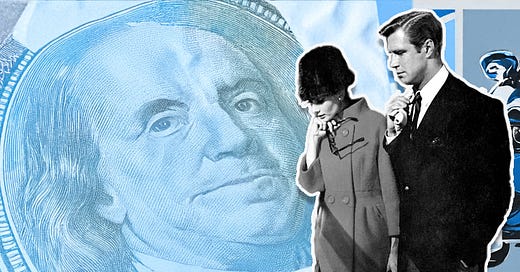“Qu’ils mangent de la brioche.”
That infamous morsel tumbled out of the mouth of some 18th-century French royal when informed that the peasants were starving and had no bread.
“Let them eat cake,” has continued to live on long after that monarch was separated from their powder-wig-covered head.
And it symbolizes the wealth divide worldwide and how the affluent don’t often suffer – or understand – the plights of those struggling.
But here’s what no one wants to admit… That phrase can also serve as a terrific guide for investors when belts start to tighten.
Williams-Sonoma (WSM) isn’t a tech stock.
It’s not involved in upending our daily lives through some medical or technological breakthrough.
It sells “precision” non-stick turners” for $37.95.
For those who might be confused, let me explain… That’s a fancy spatula.
And not a set of fancy spatulas… just one.
It sells “precision” tongs for $47.95.
Yes… tongs.
They’re not made of a rare metal or autographed by a famous chef.
They’re tongs.
You’d think with a business model built on items like that, high-end home goods retailer Williams-Sonoma would be in trouble in 2024. Particularly as U.S. inflation has remained stubbornly elevated and the constant warnings that a “recession is imminent” have droned on for two years.
But nothing could be further from the truth.
Williams-Sonoma isn’t booming… but its business has rebound from where it was during the bear market of 2022. And that in turn has rewarded shareholders.
Shares of Williams-Sonoma have surged 48.3% year-to-date.
That’s 2.5 times better than the S&P 500…
That’s nearly three times the gain of Alphabet (GOOGL) so far this year…
And more than five times the performance of Microsoft (MSFT)!
But the success of Williams-Sonoma shines the light on something all investors must understand: our two-speed market and our two-speed economy… And how investors should be positioning themselves going forward.
Discount Doldrums
Dollar Tree (DLTR) is dismal.
Shares of the discount retailer are scrabbling for ground in 2024.
They’ve lost more than 50% of their value since the start of the year.
Kohl’s (KSS), another bargain shopper’s paradise, has seen its shares shed nearly 34%.
Meanwhile, shares of Kirkland’s (KIRK) are about the same.
Often, when investors hear words being tossed about like “high inflation” and “recession,” their first instinct is to load up on discount retail brands.
But this can be a costly mistake.
Sure, there are names such as Costco (COST), Walmart (WMT) and even Ollie’s Bargain Outlets (OLLI) that will perform well as mid-tier consumers trade down.
But keep in mind, high inflation disproportionately impacts lower-income consumers. And these consumers are often the most stressed by inflation as rising gasoline, food prices and housing eat up even more of their paychecks each week.
We see the impacts of this reverberating across the retail landscape at the moment.
For instance, in the U.S., retail store closures snag headlines and paint the picture of a struggling economy. But when we look at the names leading the closures, we notice a trend…
Family Dollar – an American discount chain – is shuttering more than 600 locations… 99 Cents Only Stores are closing 371 stores… Big Lots (BIG), the discount furniture chain, is saying goodbye to 150 locations as it teeters on bankruptcy. And shares of Big Lots have tanked 99% this year and were delisted by the NYSE last month!
Remember, discount retailers are notorious for dangerously thin margins.
When their customer base starts closing their wallets, and at the same time the discount operators are hit by higher costs, it’s the perfect recipe for disaster.
Inversely, those higher income brackets aren’t feeling as much pain… If they’re even feeling pain at all.
The Perfect Cushion for a Fall
There’s a saying that, “Money can’t buy you happiness.”
Of course, we could sit here and argue the validity of that statement. But I am certain there is one thing money can buy: peace of mind.
During periods of economic stress and uncertainty, wealthy individuals often don’t suffer from stress or uncertainty.
For example, in 2024, low- and middle-income Americans have started to pull back on their spending. So, we finally started to see the slowdown economists had feared… but the reality is, that it’s mostly from one segment of the population.
Meanwhile, the wealthy continue to splurge, helping fuel overall demand.
Look no further than On Holding AG’s (ONON) performance in 2024. The high-end running shoemaker shares have surged nearly 90% year-to-date as revenue has stormed more than 34% higher.
That’s because these high-income earners have seen their overall wealth and liquid assets rise considerably over the past year and a half. In large part, thanks to the equity markets roaring higher.
Now, here’s the other part of the equation… And this is key.
Luxury brands that cater to the affluent are cash machines. They enjoy much higher margins than the rest of the retail industry. In some cases, as much as 80%! That’s because their products are produced in vastly smaller quantities than other retailers and demand significantly higher sticker prices.
Plus, these brands can raise prices without their customers feeling the pain. In fact, since 2019, luxury handbag prices have increased 50%. That’s higher than the rate of inflation during that stretch!
For investors looking for a goose-down-filled pillow to cushion their portfolios in case those calls for a U.S. recession ever come true, luxury retailers sell those pillows… And provide a high-margin option to put money to work.
Would rather eat cake than bread,
Matthew





